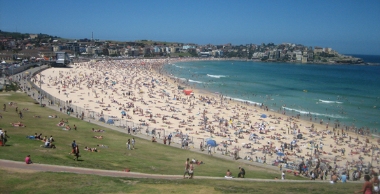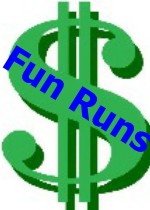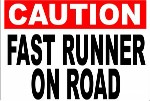Let’s face it, it costs a bit to enter a fun run these days. You’d be hard pressed to enter a marathon for much under $100 anywhere on the eastern seaboard from Brisbane to Melbourne (the Sydney M7 is a bargain at $80), and most half marathons are around the $90 mark. The city to surf is $65 if you get in early, the shorter runs associated with the Sydney Running Festival (better known as the bridge run) will set you back $55 and $40 (early bird entry) for the 9km and 3.5km respectively.
Let’s face it, it costs a bit to enter a fun run these days. You’d be hard pressed to enter a marathon for much under $100 anywhere on the eastern seaboard from Brisbane to Melbourne (the Sydney M7 is a bargain at $80), and most half marathons are around the $90 mark. The city to surf is $65 if you get in early, the shorter runs associated with the Sydney Running Festival (better known as the bridge run) will set you back $55 and $40 (early bird entry) for the 9km and 3.5km respectively.
I often hear my runners say they don’t mind the high fees to enter fun runs, as it’s helping charity. So I thought I’d take a look at just how much of your fun run entry dollar goes to charity.
I approached the organisers of a few events via email, to get a feel for what money goes where. Here are some of the responses.
EMAIL FROM HOOKED ON RUNNING
I own a running training and coaching business and many of my runners are interested to know where their entry fees for various fun runs go to. Just wondering if you could clarify a few things for me. Does any of the entry fee go to charity? and if so is that tied to people connected to that charity volunteering -eg the SES.
We’re also interested to know what percentage of the entry fee goes towards the actual running of the event, and what goes to the event manager? Any light you could shed on these questions would be apprectiated. thanks Kirsten Todd Hooked on Health Hooked on Running www.hookedonrunning.superfasttests.com
Reply from GOLD COAST MARATHON (and half marathon, 10km, 5km and 4km and 2km kids dashes).
All entry fees go to running the event. Our organisation is a not for profit organisation and as such we seek commercial sponsorship and government funding to heavily subsides our entry fees. As a consequence, we do not have the surplus to be able to designate any of the entry fee towards Charity. (My emphasis)
We are however heavily involved in promoting Charity Organisations such as Cancer Council Queensland and enlisting Every Day Heroes. To date we have managed to raise over half a million dollars for Charity.
Reply from FAIRFAX EVENTS regarding City to Surf
(they also run SMH Half Marathon, Australian Running Festival which includes the Canberra Marathon, Cole Classic Swim, Sun Run, Run4Fun).
It took a few goes to get any real information from them at all, and that was simply that they couldn’t give me any information!
Across all events run by Fairfax Media, In return for your entry fee into our events, you will receive a range of items depending on the event:
– A chest bib and timing tag (attached to the back of the bib)
– A finisher’s medal
– Public transport to and from the event, on event day
– Baggage transport from start to finish line
– Gatorade and water during and immediately after the race
– The Sun-Herald newspaper (on race day, whilst stocks last)
– Entertainment along the course and at the finish line
– Downloadable certificate
An event as large as the events that we coordinate, is very expensive to organise and execute each year. Without the support of there partners and over 3,000 volunteers it would not be possible to run such a large community event.
Representatives from various community organisations all over Sydney such as Rotary and Lions Clubs, Scouts and Girl Guides, various sporting groups, volunteer bush fire brigades, State Emergency Services, St John Ambulance and school groups help out on the day. Each of these organisations receives a per volunteer donation in appreciation for their assistance.
HOOKED ON RUNNING:
Hi Zane
I did read all of this on the city to surf website, but thanks for sending it through again. So can I clarify, that any money from entry fees that goes to charity goes to organisations who supply volunteers for the event, and any profits from the event goes to Fairfax media, or I guess Fairfax events?
FAIRFAX EVENTS
Thank you for your email. Entrants do have the opportunity to fundraise for a chosen charity or make a one off donation during the registration process. Volunteer groups do receive a donation per person for their efforts throughout event day
HOOKED ON RUNNING:
Thanks once again. We were already pretty clear on that. What is of interest to us is whether or not these events are a profit making venture for Fairfax media or Fairfax events.
FAIRFAX EVENTS
Thank you for your email. I’m afraid we won’t be able to disclose this information to you. If you do have any other questions that we might be able to help with feel free to get in contact.
I don’t know about you, but I’ve taken that to mean that Fairfax Events might well turn a profit from these events, and there is absolutely no reason why they shouldn’t.
Don’t get me wrong. I love these fun runs. They are a great community event, they get people off their bums so they feel better physically and emotionally, and a lot of money is mobilised for charity because these events exist.
But know this: For most of the larger fun run events, little or none of your actual entry fee goes to charity, unless a donation is being made on a per volunteer basis to charitable organisations such as scouts, SES, surf lifesaving etc, who provide manpower on the day. If you want all your training and your run on the day to help a charity, you need to donate to your chosen charity during the entry process, or actively raise funds by seeking sponsorship for your run, or by some other kind of fun raising.
Or……….. you could enter some of the smaller local events, which tend to cost less. A fair chunk of your entry fee can be donated to charity, due to the volunteer of the event organisers.
I asked a similar question of some local event organisers. Here are their responses:
ROSEVILLE CHASE ROTARY FUN RUN
Hello Kirsten,
The Roseville Chase Rotary Fun Run is organised primarily as a Community event to encourage good health and provide an opportunity for local family to participate in a community event. Our event caters for serious runner and of leisurely walkers.
Regarding the the Registration fees, approximately half the fees collected are used in expenses associated with the event. The other 50% all goes to support local , National and International causes and project that our Rotary Club is directly supporting or that Rotary International is supporting.
Rotary does not use any of the charity funds it raises on administration, marketing or promotional costs.
If you require more information go to www.rotary.org
MINI-MOS FUN RUN
I received a really helpful two page document from the organisers of the mimimos (thanks to Cherelle Martin). The mimimos is 100% run by volunteers, so no salaries need to be paid from your entry fees. Mosman Public School has been running the Minimos for 30 years now, so they are pretty efficient at it. It’s always a really well run event which I can highly recommend.
Here are some interesting facts about the Mini-Mos
- The break even point where the fun run costs are covered is roughly 1600-1800 entrants. Entries vary from year to year, so it’s not possible to say exactly how much of your individual entry fee goes directly to the school.
- At $45 for 10km, $35 for 5km, and $22.50 for 2 km, entry fees compare favourably to larger events
- As well as raising money for the school, the fun run provides a platform for raising funds for other charities. Like most runs theses days, participants can set up individual sponsorship pages and can make a donation online during the registration process. Other initiatives also raise funds for charities such as the Tony Abbott Challenge and items provided by high profile Minimos ambassadors for auction.
- In 2013, the Mini-Mos Fun Run raised nearly $50,000 for the school and $30, 000 for charity
Just wanted to set the record straight.





 Stroke is the second biggest killer amongst Australians, yet many of us would not be able to recognise the symptoms of stroke if we saw them. The Australian goverment recently announced $2m in funding to promote awareness of the F.A.S.T campaign, aimed at helping people to recognise the symptoms of stroke.
Stroke is the second biggest killer amongst Australians, yet many of us would not be able to recognise the symptoms of stroke if we saw them. The Australian goverment recently announced $2m in funding to promote awareness of the F.A.S.T campaign, aimed at helping people to recognise the symptoms of stroke.

 Most of us would like to be able to run just that little bit faster. Improve on that 10k PB, even if it’s only by the smallest amount. Or maybe you’re trying to maintain the times you did when you were a bit younger? It’s not so easy once you hit 40 is it? Whatever your situation, there are plenty of simple things you can do to shave more than just a few seconds off your time. Here are six of them.
Most of us would like to be able to run just that little bit faster. Improve on that 10k PB, even if it’s only by the smallest amount. Or maybe you’re trying to maintain the times you did when you were a bit younger? It’s not so easy once you hit 40 is it? Whatever your situation, there are plenty of simple things you can do to shave more than just a few seconds off your time. Here are six of them.